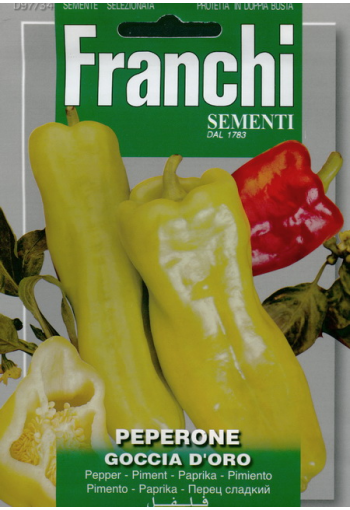Juicy fruit with a thick wall and excellent taste!
Mid-early and high-yielding variety. Suitable for growing in any climate zone. It is one of the sweetest peppers, with juicy thick-walled fruits.
Fruits are 3-4-chamber. The plant is tall, sprawling. In the stage of full ripening, the fruits become intense red.
Grade value: high palatability, long fruiting.
Recommended for fresh consumption, canning, culinary processing.
Agricultural technology.
Grown through seedlings. The depth of seed placement is up to 1.0 cm. Before emergence, the crops are covered with a film or glass. The optimum temperature for seed germination is +25°C.
Plant seedlings outdoors when danger of frost has passed. The culture is thermophilic, demanding on fertility and soil moisture.
* Growing peppers in greenhouses.
Seedlings are transferred to film greenhouses at 50-60 days of age. Planting dates depend on weather conditions and types of film greenhouses. Seedlings are planted in heated film greenhouses from late March to mid-April, in unheated ones - in mid-May.
In film greenhouses, peppers are grown on a flat surface or on ridges 120 cm wide. In low places, where the soil is waterlogged and heavy, the ridges are made high (20-30 cm). In them, the soil warms up better and is easier to maintain in a loose state. The feeding area of the plant depends on the variety.
On the ridge, seedlings of medium-sized varieties are planted in two rows with a distance between them of 40 cm, between plants in a row of 30 cm. Dwarf varieties are planted in 3-4 rows, the distance between rows is 20 cm, between plants in a row is 15 cm.
In film greenhouses, large temperature changes and high relative air humidity should not be allowed. This leads to crop loss. During the period of plant growth and development, it is generally accepted that the optimal air temperature in the greenhouse is +20+22 °C, briefly up to +26 °C; at higher temperatures, plants actively increase the vegetative mass, but the flowers are not pollinated and fall off. To reduce the temperature, greenhouses must be ventilated.
The formation of plants depends on the selected variety and growing conditions. If a variety or hybrid belongs to the group of short or medium-sized, then special shaping is not required for them. Even if the varieties are tall and grown in a film greenhouse, they also do not require shaping. In this case, it is only necessary to remove those shoots that do not bear fruit, as well as the side shoots located below the first branch of the main stem.
You should always remember that pepper is a light-loving crop and the better the illumination of the plant, the higher the yield. In dense shade, flowers are not pollinated and fall off. Tall varieties and hybrids, large-leaved, branch heavily and become bulky, which leads to shading.
After the formation of 9-10 leaves, 3 or more lateral shoots of the first order appear on the plant. From these shoots, you need to choose the 2 strongest shoots. These shoots will create the skeleton of the plant. They are left to grow, and all the rest must be pinched into 1 leaf and 1 flower.
The skeletal branches are tied to the trellis, each separately. In the future, it is necessary to monitor when the shoots are left as skeletal ones begin to branch. For each branching, you need to select the most developed shoot and leave it as the main one. The remaining, weaker shoot, located opposite, needs to be pinched after the first leaf. The same should be done with all subsequent branches of the plant. In addition, it is necessary to periodically remove side shoots and flowers growing below the branching point and yellowed leaves on the main stem. A month before the end of the growing season, pinch off the tops of the shoots. Thus, the formation of new ovaries stops, and the incoming nutrients will be distributed among the ripening fruits.











